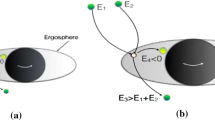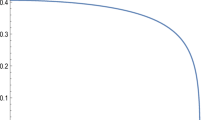Abstract
We have studied in detail the energetics of Kerr-Newman black hole by the Penrose process using charged particles. It turns out that the presence of electromagnetic field offers very favourable conditions for energy extraction by allowing for a region with enlarged negative energy states much beyondr = 2M, and higher negative values for energy. However, when uncharged particles are involved, the efficiency of the process (defined as the gain in energy/input energy) gets reduced by the presence of charge on the black hole in comparison with the maximum efficiency limit of 20.7 per cent for the Kerr black hole. This fact is overwhelmingly compensated when charged particles are involved as there exists virtually no upper bound on the efficiency. A specific example of over 100 per cent efficiency is given.
Similar content being viewed by others
References
Abramowicz, M. A., Calvani, M., Nobili, L. 1983,Nature,302, 597.
Bardeen, J. M., Press, W. H., Teukolsky, S. A. 1972,Astrophys. J.,178, 347.
Blandford, R. D., Znajek, R. L. 1977,Mon. Not. R. astr. Soc,179, 433.
Carter, B. 1968,Phys. Rev.,174, 1559.
Chandrasekhar, S. 1983,MathematicalTheory of Black Holes, Oxford University Press, New York.
Christodoulou, D. 1970,Phys. Rev. Lett.,25, 1596.
Dadhich, N. 1983,Phys. Lett.,98A, 103.
Dadhich, N. 1985, inA Random Walk in Relativity and Cosmology, Eds N. Dadhich, J. Krishna Rao, C. V. Vishveshwara & J. V. Narlikar, Wiley, Eastern, p. 72.
Denardo, G., Ruffini, R. 1973,Phys. Lett.,45B, 259.
Dhurandhar, S. V., Dadhich, N. 1984a,Phys. Rev.,D29, 2712.
Dhurandhar, S. V., Dadhich, N. 1984b,Phys. Rev.,D30, 1625.
Fishbone, L. G. 1973,Astrophys. J.,185, 43.
Kozfowski, M., Jaroszynski, M., Abramowicz, M., A. 1978,Astr. Astrophys.,63, 209.
Mashhoon, B. 1973,Astrophys. J.,181, L65.
Misner, C. W., Thorne, K. S., Wheeler, J. A. 1973,Gravitation, W. H. Freeman, San Francisco.
Parthasarathy, S., Wagh, S. M., Dhurandhar, S. V., Dadhich, N. 1985, Astrophys. J., (submitted).
Penrose, R. 1969,Rev. Nuovo Cimento,1 (Special Number), 252.
Prasanna, A. R. 1983,Astr. Astrophys.,126, 111.
Pringle, J. E. 1981,A. Rev. Astr. Astrophys.,19, 137.
Reest, M. I., Begelman, M. C., Blandford, R. D., Phinney, E. S. 1982,Nature,295, 17.
Shakura, N. I., Sunyaev, R. A. 1973,Astr. Astrophys.,24, 337.
Vishveshwara, C. 1968,J. Math. Phys.,9, 1319.
Wagh, S. M., Dhurandhar, S. V., Dadhich, N. 1985,Astrophys. J.,290, 12.
Wald, R. M. 1974,Astrophys. J.,191, 231.
Wheeler, J. A. 1971, inNuclei of Galaxies, Ed. D. J. K. O’Connell, NorthHolland, Amsterdam, p. 539.
Author information
Authors and Affiliations
Rights and permissions
About this article
Cite this article
Bhat, M., Dhurandhar, S. & Dadhich, N. Energetics of the Kerr-Newman black hole by the penrose process. J. Astrophys. Astr. 6, 85–100 (1985). https://doi.org/10.1007/BF02715080
Received:
Accepted:
Issue Date:
DOI: https://doi.org/10.1007/BF02715080




